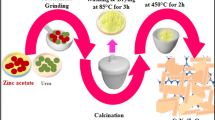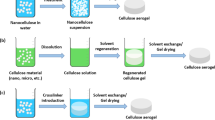Abstract
Ag–ZnO/cellulose nanocomposites with an all-weather photocatalytic performance that responds to all light conditions (including ultraviolet light, visible light, and even darkness) were fabricated by adjusting the surface groups and aspect ratios of the cellulose nanofiber substrate. The cellulose nanofibers improved the dispersibility and photostability of the Ag–ZnO nanoparticles (NPs), thereby enhancing the photocatalytic activity. The morphologies and sizes of the ZnO and Ag NPs within the Ag–ZnO/cellulose nanocomposites were controlled by using cellulose nanofibers with different surface groups and aspect ratios. ZnO NPs with average diameters of 250, 500, and 100 nm were synthesized in situ using cellulose nanocrystals (CNCs), cellulose nanofibrils (CNFs), and TEMPO-mediated oxidized cellulose nanofibrils (TOCNFs), respectively. The Ag–ZnO/TOCNF nanocomposites exhibited excellent all-weather photocatalytic performance, high loading amounts, and large effective contact area with pollutants. Free radical trapping experiments demonstrated that ·OH had the most significant effect on the photocatalytic activity. The photocatalytic activity of the Ag–ZnO/TOCNF nanocomposites was improved by preventing the recombination of electrons and holes and increasing the contact area with pollutants and light. The photogenerated electrons stored on the surface of the ZnO NPs and Ag NPs were further used for reducing H2O2 to generate ·OH free radicals in the dark, which continued to catalyze the degradation of pollutants without light irradiation. Moreover, the photocatalytic degradation of methyl orange to CO2 and H2O was confirmed via a catalytic mechanism and liquid chromatography–mass spectrometry.







Similar content being viewed by others
References
Antonopoulou M, Konstantinou I (2014) Photocatalytic treatment of metribuzin herbicide over TiO2 aqueous suspensions: removal efficiency, identification of transformation products, reaction pathways and ecotoxicity evaluation. J Photochem Photobiol A Chem 294:110–120. https://doi.org/10.1016/j.jphotochem.2014.08.008
Balachandran S, Swaminathan M (2012) Facile fabrication of heterostructured Bi2O3–ZnO photocatalyst and its enhanced photocatalytic activity. J Phys Chem C 116(50):26306–26312. https://doi.org/10.1021/jp306874z
Chen Y, Pötschke P, Pionteck J, Voit B, Qi H (2018) Smart cellulose/graphene composites fabricated byin situchemical reduction of graphene oxide for multiple sensing applications. J Mater Chem A 6(17):7777–7785. https://doi.org/10.1039/c8ta00618k
Chong M, Jin B, Chow C, Saint C (2010) Recent developments in photocatalytic water treatment technology: a review. Water Res 44(10):2997–3027. https://doi.org/10.1016/j.watres.2010.02.039
Cure J, Assi H, Cocq K, Marin L, Fajerwerg K, Fau P, Beche E, Chabal Y, Esteve A, Rossi C (2018) Controlled growth and grafting of high-density Au nanoparticles on zinc oxide thin films by photo-deposition. Langmuir 34(5):1932–1940. https://doi.org/10.1021/acs.langmuir.7b04105
Dong H, Napadensky E, Orlick J, Snyder J, Chantawansri T, Kapllani A (2016) Cellulose nanofibrils and diblock copolymer complex: Micelle formation and enhanced dispersibility. ACS Sustain Chem Eng 5(2):1264–1271. https://doi.org/10.1021/acssuschemeng.6b00811
Dong Z, Lai X, Halpert J, Yang N, Yi L, Zhai J, Wang D, Tang Z, Jiang L (2012) Accurate control of multishelled zno hollow microspheres for dye-sensitized solar cells with high efficiency. Adv Mater 24(8):1046–1049. https://doi.org/10.1002/adma.201104626
Gao M, Connor P, Ho G (2016) Plasmonic photothermic directed broadband sunlight harnessing for seawater catalysis and desalination. Energy Environ Sci 9(10):3151–3160. https://doi.org/10.1039/c6ee00971a
Guan X, Zhan Y, Yang L, Lan J, Shang J, Chen S, Li W, Lin S (2020) Durable and recyclable Ag/AgCl/CeO2 coated cotton fabrics with enhanced visible light photocatalytic performance for degradation of dyes. Cellulose 27:6383–6398. https://doi.org/10.1007/s10570-020-03241-3
Hodges B, Cates E, Kim J (2018) Challenges and prospects of advanced oxidation water treatment processes using catalytic nanomaterials. Nat Nanotechnol 13(8):642–650. https://doi.org/10.1038/s41565-018-0216-x
Huang J, Yin Z, Zheng Q (2011) Applications of ZnO in organic and hybrid solar cells. Energy Environ Sci 4(10):3861–3877. https://doi.org/10.1039/c1ee01873f
Huang P, Qin F, Lee J (2020) Role of the interface between ag and ZnO in the electric conductivity of ag nanoparticle-embedded ZnO. ACS Appl Mater Interfaces 12(4):4715–4721. https://doi.org/10.1021/acsami.9b17922
Huang Y, Qian T, Dang F, Yin Y, Li M, Zhou D (2019) Significant contribution of metastable particulate organic matter to natural formation of silver nanoparticles in soils. Nat Commun 10(1):3775. https://doi.org/10.1038/s41467-019-11643-6
Kim J, Kwon J, Kim M, Do J, Lee D, Han H (2016) Low-dielectric-constant polyimide aerogel composite films with low water uptake. Polym J 48(7):829–834. https://doi.org/10.1038/pj.2016.37
Lakshmi P, Vijayaraghavan R (2015) Insight into the mechanism of antibacterial activity of ZnO: surface defects mediated reactive oxygen species even in the dark. Langmuir 31:9155–9162. https://doi.org/10.1021/acs.langmuir.5b02266
Li H, Zhang L, Lu H, Ma J, Zhou X, Wang Z, Yi C (2020) Macro-nanoporous Al-doped ZnO/cellulose composites based on tunable cellulose fiber sizes for enhancing photocatalytic properties. Carbohydr Polym 250:116873. https://doi.org/10.1016/j.carbpol.2020.116873
Li W, Niu J, Chen Y (2012) Mechanism of photogenerated reactive oxygen species and correlation with the antibacterial properties of engineered metal-oxide nanoparticles. ACS Nano 6:5164–5173. https://doi.org/10.1021/nn300934k
Li X, Zhang L, Wang Z, Wu S, Ma J (2021) Cellulose controlled zinc oxide nanoparticles with adjustable morphology and their photocatalytic performances. Carbohyd Polym 259:117752. https://doi.org/10.1016/j.carbpol.2021.117752
Liu X, Huang K, Lin X, Li H, Tao T, Wu Q, Zheng Q, Huang L, Ni Y, Chen L, Ouyang X, Li J (2020) Transparent and conductive cellulose film by controllably growing aluminum doped zinc oxide on regenerated cellulose film. Cellulose 27:4847–4855. https://doi.org/10.1007/s10570-020-03147-0
Mantele W, Deniz E (2017) UV-vis absorption spectroscopy: lambert-beer reloaded. Spectrochim Acta A Mol Biomol Spectrosc 173:965–968. https://doi.org/10.1016/j.saa.2016.09.037
Meng L, Chen Z, Ma Z, He S, Hou Y, Li H, Yuan R, Huang X, Wang X, Wang X, Long J (2018) Gold plasmon-induced photocatalytic dehydrogenative coupling of methane to ethane on polar oxide surfaces. Energy Environ Sci 11(2):294–298. https://doi.org/10.1039/c7ee02951a
Meng S, Li D, Fu X, Fu X (2015) Integrating photonic bandgaps with surface plasmon resonance for the enhancement of visible-light photocatalytic performance. J Mater Chem A 3(46):23501–23511. https://doi.org/10.1039/c5ta06955f
Pang X, Skillen N, Gunaratne N, Rooney D, Robertson P (2021) Removal of phthalates from aqueous solution by semiconductor photocatalysis: a review. J Hazard Mater 402:123461. https://doi.org/10.1016/j.jhazmat.2020.123461
Park T, Kim N, Kim D, Kim S, Oh Y, Yoo J, You J, Um M (2019) An organic/inorganic nanocomposite of cellulose nanofibers and zno nanorods for highly sensitive, reliable, wireless, and wearable multifunctional sensor applications. ACS Appl Mater Interfaces 11(51):48239–48248. https://doi.org/10.1021/acsami.9b17824
Peng Y, Zhou H, Wu Y, Ma Z, Zhang R, Tu H, Jiang L (2022) A new strategy to construct cellulose-chitosan films supporting Ag/Ag2O/ZnO heterostructures for high photocatalytic and antibacterial performance. J Colloid Interface Sci 609:188–199. https://doi.org/10.1016/j.jcis.2021.11.155
Qin X, Shi D, Guo B, Fu C, Zhang J, Xie Q, Shi X, Chen F, Qin X, Yu W, Feng X, Liu Y, Luo D (2020) Anion-regulated synthesis of ZnO 1D necklace-like nanostructures with high photocatalytic activity. Nanoscale Res Lett 15(1):206. https://doi.org/10.1186/s11671-020-03435-5
Romão J, Mul G (2016) Substrate specificity in photocatalytic degradation of mixtures of organic contaminants in water. ACS Catalysis 6(2):1254–1262. https://doi.org/10.1021/acscatal.5b02015
Shi C, Zhang L, Bian H, Shi Z, Ma J, Wang Z (2020) Construction of Ag–ZnO/cellulose nanocomposites via tunable cellulose size for improving photocatalytic performance. J Clean Prod 288:125089. https://doi.org/10.1016/j.jclepro.2020.125089
Sun X, Yuan X, Jia Y, Feng L, Zhu F, Dong S, Liu J, Kong X, Tian H, Duan J, Ding Z, Wang S, Xing B (2020) Differentially charged nanoplastics demonstrate distinct accumulation in arabidopsis thaliana. Nat Nanotechnol 15(9):755–760. https://doi.org/10.1038/s41565-020-0707-4
Tang Y, Di W, Zhai X, Yang R, Qin W (2013) Nir-responsive photocatalytic activity and mechanism of NaYF4:Yb, Tm@TiO2 core–shell nanoparticles. ACS Catal 3(3):405–412. https://doi.org/10.1021/cs300808r
Thangavel S, Krishnamoorthy K, Krishnaswamy V, Raju N, Kim S, Venugopal G (2015) Graphdiyne–ZnO nanohybrids as an advanced photocatalytic material. J Phys Chem C 119(38):22057–22065. https://doi.org/10.1021/acs.jpcc.5b06138
Ton N, Thang B, Nguyen D, Vu T (2020) In situ charge transfer at the Ag@ZnO photoelectrochemical interface toward the high photocatalytic performance of H2 evolution and RhB degradation. ACS Appl Mater Interfaces 12(10):12195–12206. https://doi.org/10.1021/acsami.9b15578
Wang J, Yang H, Wu M, Zhang X, Xu Z-K (2017) Nanofiltration membranes with cellulose nanocrystals as an interlayer for unprecedented performance. J Mater Chem A 5(31):16289–16295. https://doi.org/10.1039/c7ta00501f
Wang Z, Ma W, Chen C, Ji H, Zhao J (2011) Probing paramagnetic species in titania-based heterogeneous photocatalysis by electron spin resonance (ESR) spectroscopy—A mini review. Chem Eng J 170(2–3):353–362. https://doi.org/10.1016/j.cej.2010.12.002
Weng B, Qi M, Han C, Tang Z, Xu Y (2019) Photocorrosion inhibition of semiconductor-based photocatalysts: basic principle, current development, and future perspective. ACS Catal 9(5):4642–4687. https://doi.org/10.1021/acscatal.9b00313
Wicklein B, Kocjan A, Salazar-Alvarez G, Carosio F, Camino G, Antonietti M, Bergstrom L (2015) Thermally insulating and fire-retardant lightweight anisotropic foams based on nanocellulose and graphene oxide. Nat Nanotechnol 10(3):277–283. https://doi.org/10.1038/nnano.2014.248
Wu W, Liang S, Shen L, Ding Z, Zheng H, Su W, Wu L (2012) Preparation, characterization and enhanced visible light photocatalytic activities of polyaniline/Bi3NbO7 nanocomposites. J Alloys Compounds 520:213–219. https://doi.org/10.1016/j.jallcom.2012.01.021
Yan L, Gu Z, Zheng X, Zhang C, Li X, Zhao L, Zhao Y (2017) Elemental bismuth–graphene heterostructures for photocatalysis from ultraviolet to infrared light. ACS Catal 7(10):7043–7050. https://doi.org/10.1021/acscatal.7b02170
Yang L, Dong S, Sun J, Feng J, Wu Q, Sun S (2010) Microwave-assisted preparation, characterization and photocatalytic properties of a dumbbell-shaped ZnO photocatalyst. J Hazard Mater 179(1–3):438–443. https://doi.org/10.1016/j.jhazmat.2010.03.023
Yeasmin S, Yeum J, Yang S (2020) Fabrication and characterization of pullulan-based nanocomposites reinforced with montmorillonite and tempo cellulose nanofibril. Carbohydr Polym 240:116307. https://doi.org/10.1016/j.carbpol.2020.116307
Yi C, Liu C, Wen K, Liu X, Zhang H, Yu Y, Fan N, Ji F, Kuang C, Ma B, Tu C, Zhang Y, Xue C, Li R, Gao F, Huang W, Wang J (2020) Intermediate-phase-assisted low-temperature formation of γ-CsPbI3 films for high-efficiency deep-red light-emitting devices. Nat Commun 11(1):4736. https://doi.org/10.1038/s41467-020-18380-1
Zhao J, Liu B, Meng L, He S, Yuan R, Hou Y, Ding Z, Lin H, Zhang Z, Wang X, Long J (2019a) Plasmonic control of solar-driven CO2 conversion at the metal/ZnO interfaces. Appl Catal B 256:117823. https://doi.org/10.1016/j.apcatb.2019.117823
Zhao S, Zheng M, Zou X, Guo Y, Pan Q (2017) Self-assembly of hierarchically structured cellulose@ZnO composite in solid–liquid homogeneous phase: synthesis, DFT calculations, and enhanced antibacterial activities. ACS Sustain Chem Eng 5(8):6585–6596. https://doi.org/10.1021/acssuschemeng.7b00842
Zhao J, Liu B, Meng L, He S, Yuan R, Hou Y (2019) Plasmonic control of solar-driven CO2 conversion at the metal/ZnO interfaces. Appl Catal B Environ 256:117823
Zhao X, Feng J, Liu J, Lu J, Shi W, Yang G, Wang G, Feng P, Cheng P (2018) Metal-organic framework-derived ZnO/ZnS heteronanostructures for efficient visible-light-driven photocatalytic hydrogen production. Adv Sci 5(4):1700590. https://doi.org/10.1002/advs.201700590|
Zou R, Li L, Yang L, Lan J, Liu H, Dou B, Shang J, Lin S (2021) CeO2/CdS heterojunction decorated cotton fabric as a recyclable photocatalyst for efficient light driven degradation of methylene blue. Cellulose 28:11081–11096. https://doi.org/10.1007/s10570-021-04203-z
Acknowledgments
This work was supported by the National Natural Science Foundation of China [Grant Numbers 31870565]; the fellowship of China Postdoctoral Science Foundation [Grant Number 2020m671505]; University Science Research Project of Jiangsu Province [Grant Number 20KJB220011]; and Graduate Research and Innovation Projects of Jiangsu Province [Grant Number KYCX21_0882].
Author information
Authors and Affiliations
Contributions
CS and LZ contributed equally to this work. The manuscript was written through contributions of all authors. All authors have given approval to the final version of the manuscript.
Corresponding authors
Ethics declarations
Conflict of interest
The authors declare that they have no competing financial interests. This article does not contain any studies with human participants or animals performed by any of the authors.
Additional information
Publisher's Note
Springer Nature remains neutral with regard to jurisdictional claims in published maps and institutional affiliations.
Electronic supplementary material
Below is the link to the electronic supplementary material.
Appendix A
Appendix A
Physical properties of Ag–ZnO/cellulose nanocomposites (Table S1); Nitrogen adsorption desorption curve and pore size distribution of different nanocomposites (Fig. S1); TEM images of different ratio of Ag/ZnO for Ag-ZnO/TOCNF nanocomposites (Fig. S2).
Rights and permissions
About this article
Cite this article
Shi, C., Zhang, L., Shi, Z. et al. All-weather Ag–ZnO/cellulose photocatalysts tailored by surface groups and aspect ratios of cellulose nanofibers. Cellulose 29, 2289–2304 (2022). https://doi.org/10.1007/s10570-022-04438-4
Received:
Accepted:
Published:
Issue Date:
DOI: https://doi.org/10.1007/s10570-022-04438-4




